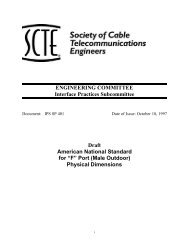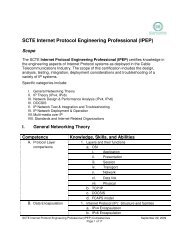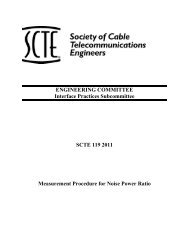ANSI/SCTE 16 2001R2007
ANSI/SCTE 16 2001R2007
ANSI/SCTE 16 2001R2007
You also want an ePaper? Increase the reach of your titles
YUMPU automatically turns print PDFs into web optimized ePapers that Google loves.
The relationship of the peak to peak hum waveform to the peak to peak reference modulation is<br />
simply:<br />
⎛ V ⎞<br />
⎜<br />
hum<br />
20 Log<br />
⎟ as measured on the oscilloscope. (A – 18)<br />
⎝ Vref<br />
⎠<br />
Combining these two relationships, the peak to peak hum is related to the peak carrier by:<br />
⎛ V ⎞<br />
⎜<br />
hum<br />
Hum (dB) = 20Log(k) + 20Log<br />
⎟ or (A – 19)<br />
⎝ Vref<br />
⎠<br />
Hum(dB)<br />
= 20Log(k) − 20Log(V ) 20Log(V ) . (A – 20)<br />
ref +<br />
A convenient modulation index to use is 0.5% AM. If this value is substituted for m, the first<br />
term in equation A-20 becomes –40.04 dB. If a higher degree of accuracy is required, the<br />
modulation index can be empirically determined by measuring the carrier and its sidebands<br />
across the test spectrum. From HP application note #150-1, the relationship between the<br />
logarithmic display and the modulation percentage is expressed as:<br />
(dB)<br />
E −E<br />
C(dB)<br />
+ 6) / 20<br />
hum<br />
20log m = E SB − E + 6dB (A - 21)<br />
(<br />
C<br />
SB<br />
m = 10<br />
(A – 22)<br />
17

















